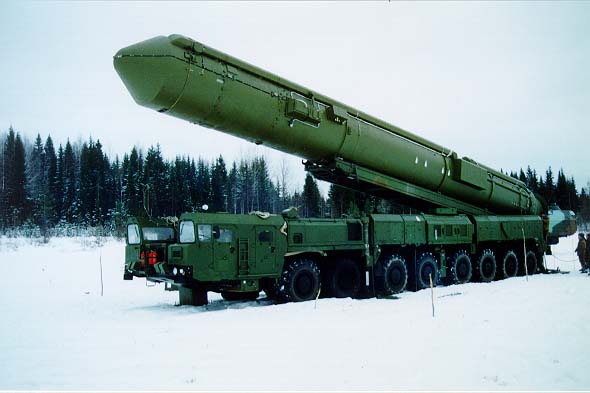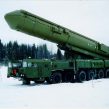
General Makarov Highlights the “Risk” of Nuclear Conflict
Publication: Eurasia Daily Monitor Volume: 8 Issue: 221
By:

In the current election season the Russian media has speculated that the Defense Minister Anatoliy Serdyukov may be replaced, possibly by Dmitry Rogozin, Russia’s Ambassador to NATO, which masks deeper anxiety about the future direction of the Armed Forces. The latest rumors also partly reflect uncertainty surrounding how the switch in the ruling tandem may reshuffle the pack in the various ministries, as well as concern about managing complex processes in Russian defense planning. On November 17, Russia’s Chief of the General Staff, Army-General Nikolai Makarov, offered widely reported comments on the potential for nuclear conflict erupting close to the country’s borders. His key observation was controversial, based on estimating that the potential for armed conflict along the entire Russian periphery had grown dramatically over the past twenty years (Profil, December 1; Moskovskiy Komsomolets, November 28; Interfax, November 17).
During his speech to the Defense Ministry’s Public Council on the progress and challenges facing the effort to reform and modernize Russia’s conventional Armed Forces, Makarov linked the potential for local or regional conflict to escalate into large-scale warfare “possibly even with nuclear weapons.” Many Russian commentators were bewildered by this seemingly “alarmist” perspective. However, they appear to have misconstrued the general’s intention, since he was actually discussing conflict escalation (Interfax, ITAR-TASS, November 17; Moskovskiy Komsomolets, Krasnaya Zvezda, November 18).
Makarov’s remarks, particularly in relation to the possible use of nuclear weapons in war, were quickly misinterpreted. Three specific aspects of the context in which Russia’s most senior military officer addressed the issue of a potential risk of nuclear conflict may serve to necessitate wider dialogue about the dangers of escalation. There is little in his actual assertion about the role of nuclear weapons in Russian security policy that would suggest Moscow has revised this; in fact, Makarov stated that this policy is outlined in the 2010 Military Doctrine, though he understandably made no mention of its classified addendum on nuclear issues (Kommersant, November 18).
Russian media coverage was largely dismissive of Makarov’s observations, focusing on the idea that he may have represented the country as being surrounded by enemies. According to Kommersant, claiming to have seen the materials used during his presentation, armed confrontation with the West could occur partly based on the “anti-Russian policy” pursued by the Baltic States and Georgia, which may equally undermine Moscow’s future relations with NATO. Military conflict may erupt in Central Asia, caused by instability in Afghanistan or Pakistan; or western intervention against a nuclear Iran or North Korea; energy competition in the Arctic or foreign inspired “color revolutions” similar to the Arab Spring and the creation of a European Ballistic Missile Defense (BMD) system that could undermine Russia’s strategic nuclear deterrence also featured in this assessment of the strategic environment (Kommersant, November 18).
Since the reform of Russia’s conventional Armed Forces began in late 2008, Makarov has consistently promoted adopting network-centric capabilities to facilitate the transformation of the military and develop modern approaches to warfare. Keen to displace traditional Russian approaches to warfare, and harness military assets in a fully integrated network, Makarov possibly more than any senior Russian officer appreciates that the means and methods of modern warfare have changed and are continuing to change (Zavtra, November 23; Interfax, November 17).
The contours of this evolving and unpredictable strategic environment, with the distinctions between war and peace often blurred, interface precisely in the general’s expression of concern about nuclear conflict: highlighting the risk of escalation. However, such potential escalation is linked to the reduced time involved in other actors deciding to intervene in a local crisis as well as the presence of network-centric approaches among western militaries and being developed by China and Russia. From Moscow’s perspective, NATO “out of area operations” from Kosovo to Libya blur the traditional red lines in escalation; further complicated if any power wishes to pursue intervention in complex cases such as Syria. Potential escalation resulting from local conflict, following a series of unpredictable second and third order consequences, makes Makarov’s comments seem more understandable; it is not so much a portrayal of Russia surrounded by “enemies,” as a recognition that, with weak conventional Armed Forces, in certain crises Moscow may have few options at its disposal (Interfax, November 17).
There is also the added complication of a possibly messy aftermath of the US and NATO drawdown from Afghanistan and signs that the Russian General Staff takes Central Asian security much more seriously in this regard. The General Staff cannot know whether the threat environment in the region may suddenly change. Makarov knows the rather limited conventional military power Russia currently possesses, which may compel early nuclear first use likely involving sub-strategic weapons, in an effort to “de-escalate” an escalating conflict close to Russia’s borders. Moscow no longer primarily fears a theoretical threat of facing large armies on its western or eastern strategic axes; instead the information-era reality is that smaller-scale intervention in areas vital to its strategic interests may bring the country face-to-face with a network-centric adversary capable of rapidly exploiting its conventional weaknesses. As Russia plays catch-up in this technological and revolutionary shift in modern warfare capabilities, the age-old problem confronts the General Staff: the fastest to act is the victor (See EDM, December 1). Consequently, Makarov once again criticized the domestic defense industry for offering the military inferior quality weapons systems. Yet, as speed and harnessing C4ISR (Command, Control, Communications, Computers, Intelligence, Surveillance and Reconnaissance) become increasingly decisive factors in modern warfare, the risks for conflict escalation demand careful attention – especially when the disparate actors possess varied capabilities.
Unlike other nuclear powers, Russia has to consider the proximity of several nuclear actors close to its borders. In the coming decade and beyond, Moscow may pursue dialogue with other nuclear actors on the nature of conflict escalation and de-escalation. However, with a multitude of variables at play ranging from BMD, US Global Strike capabilities, uncertainty surrounding the “reset” and the emergence of an expanded nuclear club, and several potential sources of instability and conflict, any dialogue must consider escalation in its widest possible context. Makarov’s message during his presentation, as far as the nuclear issue is concerned, was therefore a much tougher bone than the old dogs of the Cold War would wish to chew on.




